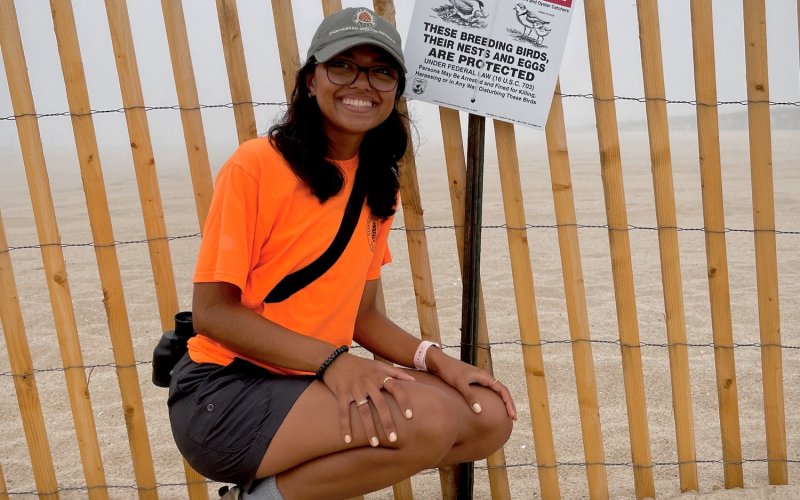5 Questions with Mya Darsan

ALBANY, N.Y. (July 15, 2021) – Did you know that the small, sand-colored bird you sometimes see during trips to East Coast beaches are actually an endangered species? Junior biology and environmental science student Mya Darsan is dedicating her summer to protecting these birds – piping plovers – and wishes people understood that species like this are important in maintaining biodiversity in an ecosystem. Darsan, who hails from Centereach in Suffolk County, took time away from her internship to answer some questions.
What are you working on this summer?
I am working as an endangered species steward in the Suffolk County Department of Parks’ Endangered Species Program, for piping plovers and other shorebirds. My crew and I live and work in eastern Suffolk County where we go to beaches, such as in the Hamptons and Montauk, and monitor shore bird activity. Our main focus is on the piping plovers, which are endangered in New York. We monitor the birds’ nesting activities, mating patterns and reproductive success while also installing and maintaining protective measures as delineated by United States Fish and Wildlife Services (USFWS) guidelines.
What is your favorite part of your stewardship?
I really enjoy doing fieldwork and getting to be outside. I've learned so much from physically working within the environment that I can’t experience in the classroom. I also really enjoy the group of people I get to work with. It is great getting to work with a group of people who all have a shared goal and views on the environment.
What does a typical day look like?
We meet in our office at 7 a.m. to look through our books and calendar to determine which sites we will go to that day based on hatch dates, fledge dates, etc. We try to see all of our sites at least once a week and we typically visit two to four sites per day. When we arrive to the site, we spread across the shore and up to the high dunes to begin monitoring by tandem walking along the whole beach. The nests (and chicks) are very well camouflaged in the sand and dunes so we must carefully watch our steps.
If we spot a piping plover, we stop to observe its behavior. If the bird is acting defensive (broken winging, peeping, false sitting), we begin looking for a nest or chicks. Once we find the nest we mark the GPS coordinates, the number of eggs laid and identify/label the pair of adults. If the nest is not within the string fencing, we will install more fencing, and if we believe the nest is at risk of predation we will install an enclosure around the nest.
While we walk through each site, we also check on previously found nests. When a nest hatches, we try to determine the exact hatch date so we can predict when the chicks will fledge. As we walk down the beach monitoring, we also check that protective measures are intact, as well as for signs of predators (dog prints, tire tracts, people within fencing), and we look for other shorebirds, such as American oystercatchers, least terns and common terns.
Once we have checked all of the day’s sites, we head back to fill out our daily reports and pair sheets (each nest has a pair sheet where we keep track of all the data we collect throughout the season). We do various other tasks (such as the Colonial Water Bird Survey) but this is just a typical day for our crew. Our goal is to maintain, monitor and protect the piping plovers and their environment.
What is something you wish people knew about this type of work?
I wish people knew how important maintaining biodiversity within an ecosystem is. We get a lot of backlash from our work. On many occasions, we've had to close beaches due to USFWS guidelines on piping plover activity. People are not happy that we close the beach for a bird and often get quite angry about it — They’ll come up to us to tell us things like they “taste like chicken,” that the birds aren’t actually endangered, they’re just birds so we should “let nature take its course.” We also hear very interesting conspiracy theories. Piping plovers are an indicator species; researchers use indicator species to evaluate the health of an ecosystem. Although they are just “little birds” they are very important in maintaining a healthy ecosystem.
What are your career aspirations?
As of right now, I would like to attend graduate school and continue to study conservation, ecosystem management and ecology (or a related field). I hope to do some research in my future as well.




